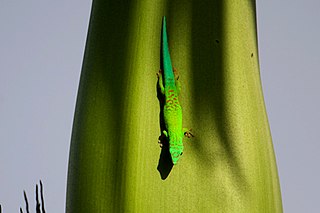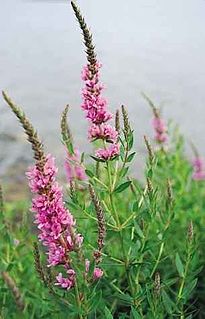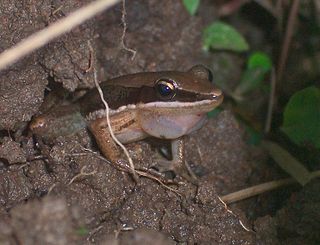
The Andaman Islands, union territory of India, are an archipelago in the northeastern Indian Ocean about 130 km (81 mi) southwest off the coasts of Myanmar's Ayeyarwady Region. Together with the Nicobar Islands to their south, the Andamans serve as a maritime boundary between the Bay of Bengal to the west and the Andaman Sea to the east. Most of the islands are part of the Andaman and Nicobar Islands, a Union Territory of India, while the Coco Islands and Preparis Island in the archipelago's north belong to Myanmar.

The Andaman day gecko, also known as the Andaman Islands day gecko, is a species of gecko in the genus Phelsuma. It is endemic to the Andaman Islands of India, and has recently been introduced to the Nicobar islands. It is a small, slender lizard, has a bright green colour and feeds on insects. Its range is nearly 5000 km away from the centre of the distribution area of the genus Phelsuma, in Mauritius and Madagascar.

Lythraceae is a family of flowering plants, including 32 genera, with about 620 species of herbs, shrubs, and trees. The larger genera include Cuphea, Lagerstroemia (56), Nesaea (50), Rotala (45), and Lythrum (35). It also includes the pomegranate and the water caltrop. Lythraceae has a worldwide distribution, with most species in the tropics, but ranging into temperate climate regions as well.

The Great Nicobar Biosphere Reserve encompasses a large part of the island of Great Nicobar, the largest of the Nicobar Islands in the Indian Union Territory of Andaman and Nicobar Islands. The Nicobars lie in the Bay of Bengal, eastern Indian Ocean, 190 km to the north of the Indonesian island of Sumatra. The Reserve has a total core area of approximately 885 km2, surrounded by a 12 km-wide "forest buffer zone".In year 2013 it was included in the list of Man and Biosphere program of UNESCO to promote sustainable development based on local community effort and sound science.

Narcondam, India's easternmost Island, is a small volcanic island located in the northern Andaman Sea. The island's peak rises to 710 m above mean sea level, and it is formed of andesite. It is part of the Andaman Islands, the main body of which lie approximately 124 km (77 mi) to the east.The island is part of the Indian union territory of Andaman and Nicobar Islands. The island is small, covering an area of approximately 6.8 square kilometres. It was classified as a dormant volcano by the Geological Survey of India.

Boiga andamanensis, known commonly as the Andaman cat snake, is a species of rear-fanged mildly venomous snake in the family Colubridae. The species is endemic to the Andaman Islands.

Bungarus andamanensis, the South Andaman krait, is a species of krait, a venomous elapid snake, which is found in the Andaman Islands of India.

Mount Harriet National Park is a national park located in the Andaman and Nicobar Islands union territory of India. The park, established in 1969, covers about 4.62 km2 (18.00 mi2). Mount Harriet, which is part of the park, is the third-highest peak in the Andaman and Nicobar archipelago next to Saddle Peak in North Andaman and Mount Thullier in Great Nicobar.
Minervarya andamanensis, commonly known as the Andaman frog, chestnut-brown frog, or Andaman wart frog is a species of frog only found in the Andaman Islands, India. It has been regarded as a synonym of Limnonectes limnocharis, but is now considered a valid species. A related, unnamed species exists in western Thailand.

Minervarya nicobariensis, the Nicobar frog or Nicobar cricket-frog, is a species of frog endemic to the Nicobar Islands of India. In the past it has been considered to be the same species as Fejervarya andamanensis from the neighbouring Andaman Islands, but is now regarded a valid species. It is restricted to the central and northern group of Nicobar Islands. It is relatively common in suitable habitat, particularly on Car Nicobar island. Its preferred habitat are grasslands, where the species breeds in the rainwater puddles. On Car Nicobar, it also occurs coastal wetlands and along newly cleared forest trails.

The Andaman coucal or brown coucal is a species of non-parasitic cuckoo found in the Andamans, Coco and Table Islands. It is sometimes treated as a subspecies of the greater coucal. It is found mainly in forested habitats and thickly covered gardens.

Phoenix andamanensis is a wild relative of date palm endemic to the Andaman Islands in the Bay of Bengal southwest of Myanmar. It is rather a newly described taxon by Sasha C. Barrow in 1998 based on old herbarium collections. This taxon was known only from a few herbarium collections and a few insignificant citations by Kurz in 1870, Brandis in 1906 and Parkinson in 1923. The Herbarium collections were made mostly during the British regime in 1903, 1904 and 1911 by Rogers and Osmaton. Later, Ellis from the Botanical Survey of India in 1990 collected one specimen from the Saddle Peak. The specimens were remained unidentified at herbaria until its circumscription as new taxon by Barrow in 1998.

The Andaman shrew or Andaman white-toothed shrew is a critically endangered species of mammal in the family Soricidae. It is endemic to the South Andaman Island of India. They are usually active by twilight or in the night and have specialized habitat requirements. Habitat loss due to selective logging, natural disasters such as tsunami and drastic weather change are thought to contribute to current population declines.

Rotala is a genus of plants in the loosestrife family. Several species are used as aquarium plants.

Pinanga andamanensis is one of the critically endangered species of endemic palms reported from the Andaman Islands.

Pseudocalotes andamanensis is an agamid lizard found on the Nicobar Islands and the Andaman Islands in India. It is also known as the green crestless forest lizard, Andaman and Nicobar forest lizard, Andaman lizard, or Andaman green calotes. This species is an almost exclusive canopy dweller, and is rarely seen.

Chaetodon andamanensis, commonly known as the Andaman butterflyfish, is a species of marine ray-finned fish, a butterflyfish belonging to the family Chaetodontidae. It is native to the Indian Ocean.

Mimusops andamanensis is a species of plant in the family Sapotaceae. It is native to Sri Lanka and the Andaman Islands.















